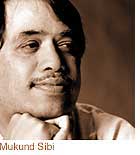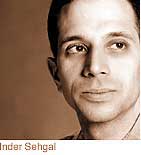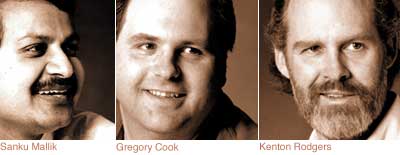
In science, there is no such thing as an overnight success. You write proposals, seek funding, experiment, publish findings, interact with other scientists. It is a thing of hard work and a little luck, of intellect and determination. The pressure is on to publish your findings so that other researchers may capitalize and the stream of research goes on. The body of knowledge expands.
 It's what chemist Mukund Sibi calls putting in your 2 cents worth.
It's what chemist Mukund Sibi calls putting in your 2 cents worth.
Surely it's an understatement to say that all this astoundingly complex research becomes a mere drop in a huge bucket of knowledge, but it certainly is a cumulative, collaborative process. Serendipity, if you will.
Plans Meet With Reality
Sibi is a professor at North Dakota State University. The story of his career, in many ways, is typical. He came to the campus in 1987 with a solid idea for a research program, and made adjustments as opportunities arose. Science never works the way you plan, Sibi says.
Having come to NDSU from a postdoc position with the scientist who developed Taxol one of the most important cancer drugs in the past 20 years Sibi's plan was to work on validation of a mechanism in chemotherapy. As AIDS became a bigger problem in America, he adapted his work to include synthesizing compounds that might be helpful in treating the disease.
He adjusted again after a couple of years, when a chemistry colleague and the dean of agriculture asked him to help with some research in crambe. You get the picture. One thing led to the other, involving new colleagues in the chemistry department, new graduate students, more opportunities. We had the right combination of interests and people, Sibi says, so we made some spectacular discoveries.
The Stream of Research
Scientists compete fiercely for funding, argue about findings and challenge one another's assertions. But collaborating is a necessity. No matter how good you are individually, you are dependent on people to participate, Sibi says. Everyone has to put their 2 cents in for the program to work.
This is true both in a particular lab, as well as throughout the discipline. A spectacular example involves James D. Watson and Francis Crick, working together in the 1950s. They generated no original data in identifying the structure of DNA. They simply put together the pieces.
The explosion of Internet technology has changed the scope and pace of scientific interaction. What began as a way for physicists to communicate with greater ease has evolved rapidly to become a powerful tool for scientists in all fields, not to mention the explosion in commercial and personal activity.
Phil Boudjouk, NDSU's vice president for research, creative activities and technology transfer, is a chemist who has seen the Internet grow and the capabilities completely change how he does business. Many of the journals publish on the Internet before coming out in print. Many of us have gotten an email in the morning from halfway around the globe, and the journal had just come out at midnight, he says. Ten years ago it would have been five months before they got the journal, if they could get it at all.
In the sense that science is a problem-solving enterprise, it has succeeded in many areas. There are diseases nobody knows much about any more. Polio and others have disappeared, Boudjouk says. On the other hand, in muscular dystrophy we're not making the kind of progress we'd like and much work needs to be done on cancer research.
People show tremendous trust that we are going to do our best to help meet their needs. We have hungry people and we have sick people. There are many things we need to take care of, Boudjouk says. The public trusts us to do this.
Credibility is The Coin of The Realm.'
Sibi and several NDSU chemists and pharmaceutical scientists can now collaborate in a more deliberate fashion, having landed a five-year $8.2 million grant from the National Institutes of Health. Competition for this funding came from universities across the country. They don't give that kind of money to people who just might like to give it a whirl, Boudjouk says. Credibility is the coin of the realm.
The grant is funding a Center for Biomedical Research Excellence, to be known as COBRE, at NDSU. The center will focus on a class of enzymes called matrix metalloproteinases, or MMPs, which play vital roles in biological processes. In humans, for example, hundreds of enzymes mediate many physiological functions and each has a specific responsibility.
The MMPs belong to a class of enzymes called proteases (pronounced pro-tea-ase) that degrade proteins by cutting them into small pieces. Too much or too little MMP activity can contribute to diseases such as arthritis, cancer, multiple sclerosis and diabetes. Controlling enzyme activity by using pharmaceuticals is seen as a potential strategy for treating the disease.
What sets this center apart is that it is a combination of chemists and pharmacists attacking these diseases at the most fundamental level, Boudjouk says.
The project will have three components: designing new drugs through theoretical computer models; using the theoretical designs to create the drugs in the laboratory; and testing the new drugs in biological systems to determine their actual effects or actions on live human tissues and cells.

 Inder Sehgal, an assistant professor, and Stefan Balaz, associate professor, both in pharmaceutical science, are among the COBRE leaders. My part of our project allows me to do what I do best growing human cells in culture and then expand my research program by developing assays to test new approaches to treat protease-associated diseases, says Sehgal.
Inder Sehgal, an assistant professor, and Stefan Balaz, associate professor, both in pharmaceutical science, are among the COBRE leaders. My part of our project allows me to do what I do best growing human cells in culture and then expand my research program by developing assays to test new approaches to treat protease-associated diseases, says Sehgal.
Balaz says the cooperative, multidisciplinary approach is crucial. For years I have been developing the methods of subcellular pharmacokinetics for modeling of drug distribution in cells, tissues and organisms, as well as the molecular modeling approaches for description of drug-receptor interactions, he says. This project is a tremendous chance to apply the theoretical methods to an important real-world problem.

Other scientists in COBRE are chemists Gregory Cook, Sanku Mallik and Kenton Rodgers. They know how much impact $8.2 million can have, especially a high-profile grant from the National Institutes of Health. First, the work to be carried out by the investigators will contribute to our understanding of several important diseases, Rodgers says. Second, in addition to its contribution to the improvement of public health, the center will be uniquely poised to improve the biomedical aspect of graduate and undergraduate education at NDSU. Finally, the fiscal magnitude of this grant will impact the Fargo-Moorhead community in a very positive way.
Keeping the balls in the air
Post-docs, graduate students, undergraduate students are integral to the success of a research program. They're also hard to find. But, as in many disciplines, successes build upon themselves. So if you've been able to get enough funding to do the work and write an article that gets accepted in a well-known journal, you may get invited to a national or international meeting where, in addition to sharing your work and hearing ideas from other scientists, you may recruit new students.
Sibi is putting his recruiting skills to the test as director of COBRE, which will require new faculty, students, postdocs and technicians. The search for a new faculty member is promising.
Getting and maintaining funding once you have a program in place isn't easy. You have to write a lot of proposals, Sibi says. This NIH grant the largest in the institution's history may well have opened the doors for NDSU to become a more research-oriented institution. President Joseph Chapman has said since he took the job two years ago that North Dakota State University should seek a higher level of research activity. According to recently-revised Carnegie Foundation standards, NDSU is a Doctoral and Research University-Intensive. Chapman is making way for the next level. Our goal of moving to Doctoral/Research-Extensive is about finding ways for North Dakota State University to best serve this state, Chapman says.
That classification requires the graduation of 50 or more doctorates in at least 15 academic disciplines per year. To that end, with the help of a donor group called The President's Circle, some 20 new doctoral fellowships have been established. New doctoral programs have been added in communication and psychology. Others are in the works.
In the sense that the role of researchers at a university is to develop future researchers, these changes are significant. As we bring new discovery, new ideas and outstanding research to this institution, our students will be interacting directly with top-notch investigators exploring innovative ways of making things better, says Chuck Peterson, dean of pharmacy.
L. McDaniel

































